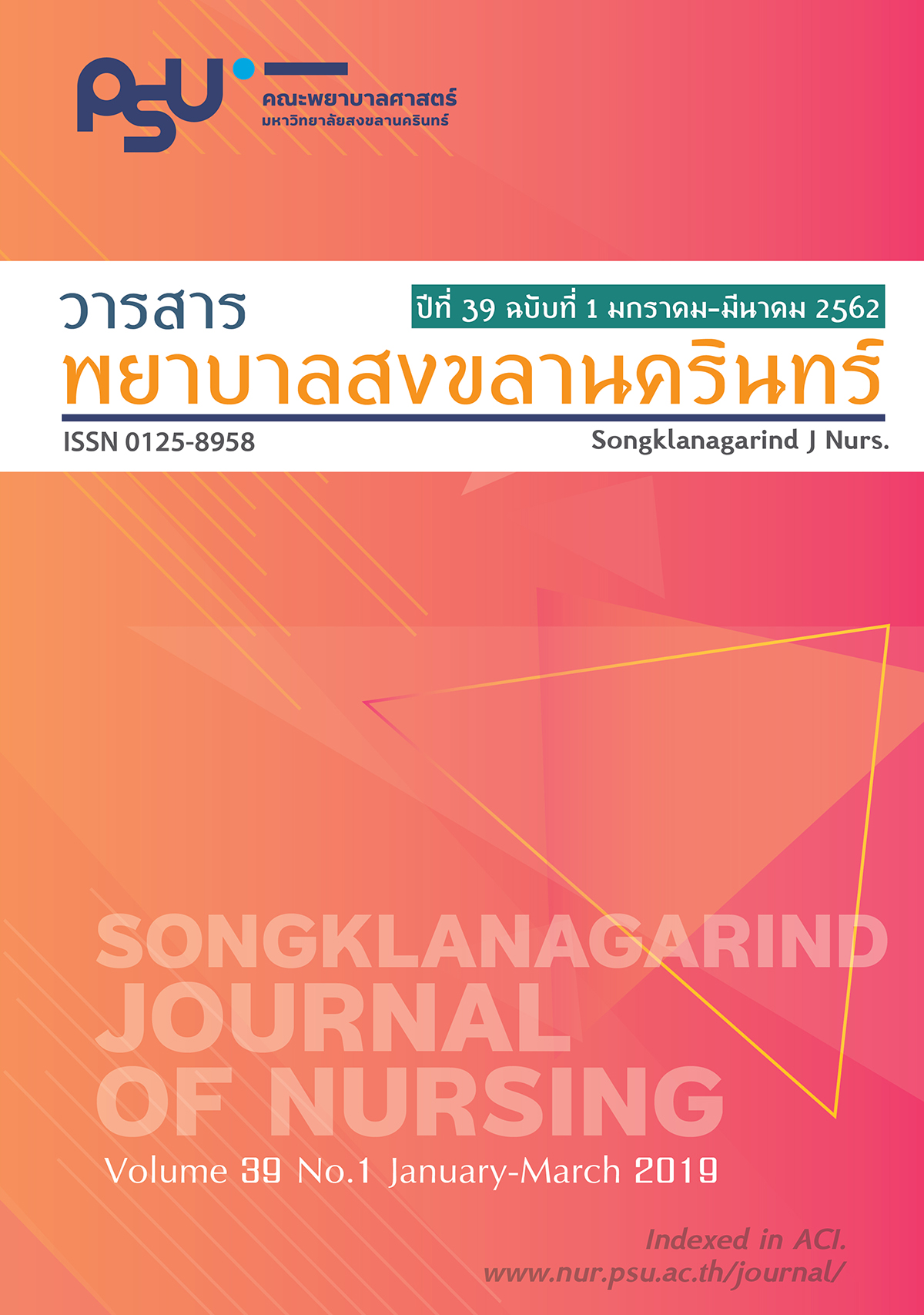Prevalence, Impact and Self-Management of Dysmenorrhea Among Nursing Students
Main Article Content
Abstract
Dysmenorrhea or menstrual pain is a common health problem among reproductive women and is reported as the most common reason for school absence. The purposes of this descriptive study were to explore the prevalence, intensity, and impact of dysmenorrhea and to describe the type and effectiveness of dysmenorrhea self-management strategies used by participants. One thousand and sixty-fve, 17-25 year old, nursing students were recruited. Data related to occurrence, intensity and impact of dysmenorrhea were obtained through the use of the Women’s Daily Health Diary (DHD) and the negative impact section of the Daily Record of Severity of Problem (DRSP). The type and effectiveness of dysmenorrhea self-management strategies used by the participants were obtained by Self-Management Measures Questionnaire (SMMQ).
Results revealed the prevalence of dysmenorrhea to be 66.1%. The greatest intensity of symptoms occurred during menstruation days, besides menstrual, pain, fatigue, increased sleep pattern, backache and irritability were also reported. The most disruptive negative impact of dymenorrhea was decreased concentration whilst reading textbooks and reduced ability to concentrate during lessons. Dysmenorrhea resulted in school absence of 13.8%.
The most common self-management strategies used to alleviate dysmenorrhea were drinking warm water (73.3%), taking pain relief medicine (67.9%) and doing nothing to relieve pain (62.1%). Taking pain relief medicine was the most effective way to alleviate dysmenorrhea. The overall effectiveness of any strategy only achieved a moderate level of pain reduction was reported with decreasing in moderate level. The reported overall effectiveness of self-management strategies for dysmenorrhea was a reduction in symptoms to a moderate level. The fndings suggest that the most common self-management strategies was not necessary to be the most effectiveness technique to relieve the symptom of dysmenorrhea.
Article Details
References
Lacovides S, Avidon I, Baker FC. What we know about primary dysmenorrhea today: A critical review. Hum Reprod Update. 2015; 21(6): 762-78.
Lefebvre G, Pinsonneault O, Antao V, Black A, Burnett M, Feldman K, Lea R, Robert M, SOGC. Primary dysmenorrhea consensus guideline. J Obstet Gynaecol Can [internet] 2013 [cited 2018 Oct 4.] 27(12):1117-46. Available from: https:// sogc.org/wp-content/uploads/2013/01/169E-CPG-December2005.pdf
Hailemeskel S, Demissie A, Assefa N. Primary dysmenorrhea magnitude, associated risk factors, and its effect on academic performance: evidence from female university students in Ethiopia. Int J Womens Health. 2016; 8: 489-96. doi: https:// doi.org/10.1186/s12905-018-0552-x
Omidvar S, Begum K. Menstrual pattern among unmarried women from south India. J Nat Sci Biol Med. 2011; 2:174-9.
De Sanctis V, Soliman A, Bernasconi S, Bianchin L, Bona G, Bozzola M, et al. Primary dysmenorrhea in adolescents: Prevalence, impact and recent knowledge. Pediatr Endocrinol Rev. 2015; 13: 512-20.
Ortiz MI. Primary dysmenorrhea among Mexican university students: Prevalence, impact and treatment. Eur J Obstet Gynecol Reprod Biol. 2010; 152:73-7.
Ju H, Jones M, Mishra G. The prevalence and risk factors of dysmenorrhea. Epidemiol Rev. 2014; 36: 104-13.
Tanmahasamut P, Chawengsettakul S. Dysmenorrhea in Siriraj medical students, prevalence, quality of life, and knowledge of management. J Med Assoc Thai. 2012; 95: 1115-21.
Midilli TS, Yasar E, Baysal E. Dysmenorrhea characteristics of female students of health school and affecting factors and their knowledge and use of complementary and alternative methods. Holist Nurs Pract. 2015; 29: 194-204.
Dodd M, Janson S, Facione N, Faucett J, Froelicher E, Humphreys J, et al. Advancing the science of symptom management. J Adv Nurs. 2001; 33(5): 668-76.
Micthell ES, Woods NF, Lentz M.J. Recognizing PMS when you see it: Criteria for PMS sample selection. In D. Taylor & N. F. Woods (Eds.), Menstruation, health, and illness. New York: Hemispher; 1991.
Butsripoom B, Hanucharurnkul S, Arpanantikul M, et al. Premenstrual syndrome among Thai nurses: Prevalence, impact and self-management strategies. PRIJNR [Internet]. 2009 [cited 2018 Oct 4.]; 13(4): 285-301. Available from: https:// www.tci-thaijo.org/index.php/PRIJNR/article/ view/6473
Endicott J, Nee J, Harison W. Daily record of severity of problem (DRSP): Reliability and validity. Arch Womens Ment Health. 2006; 9: 41-49.
Righarts A, Osborne L1, Connor J, et al. Prevalence and potential determinants of dysmenorrhoea and other pelvic pain in women: a prospective study. BJOG 2018; https:// doi.org/10.1111/1471-0528.15280.
Subasinghe AK, Happo L, Jayasinghe YL, et al. Prevalence and severity of dysmenorrhoea, and management options reported by young Australian women. Aust Fam Physician [internet]. 2016 [cited 2018 June 24]; 45:829-34. Available from: https://www.racgp.org.au/download/Documents/AFP/2016/November/AFP-Nov-Research- Subasinghe.pdf
Ameade EPK, Amalba A, Mohammed BS. Prevalence of dysmenorrhea among university students in northern Ghana; Its impact and management strategies. BMC Women’s Health [internet]. 2018 [cited 2018 June 24]. Available from: https://www.ncbi.nlm.nih.gov/pmc/articles/PMC5810012/pdf/12905_2018_Article_532.pdf
Abu Helwa HA, Mitaeb AA, Al-Hamshri S, Sweileh WM. Prevalence of dysmenorrhea and predictors of its pain intensity among Palestinian female university students. BMC Women’s Health [internet]. 2018 [cited 2018 June 24]. Available from: https://www.ncbi.nlm.nih.gov/pmc/articles/PMC5769430/pdf/12905_2018_Article_516.pdf
Cheng H, Lin Y. Selection and efficacy of self-management strategies for dysmenorrhea in young Taiwanese women. J Clin Nurs. 2010; 20:1018–25.
Al-Kindi R, Al-Bulushi A. Prevalence and impact of dysmenorrhea among Omani high school students. SQU Medical J. 2011; 11(4): 485-91.
Hong J, Mark J, Gita M. The prevalence and risk factors of dysmenorrhea. Epidemiol Rev. 2014; 36(1):104-13. doi: https://doi.org/10.1093/epirev/mxt009
Yesuf TA, Eshete NA, Sisay EA. Dysmenorrhea among university health science students, northern Ethiopia: Impact and associated factors. Int J Reprod Med [internet]. 2018 [cited2018 June 24]. Available from: https://www.ncbi.nlm.nih.gov/ pmc/articles/PMC5828460/pdf/IJRMED2018-9730328.pdf
Hailemeskel S, Demissie A, Assefa N. Primary dysmenorrhea magnitude, associated risk factors, and its effect on academic performance: Evidence from female university students in Ethiopia. Int J Womens Health. 2016; (8):489-96. doi: https:// doi.org/10.1186/s12905-018-0552-x
Ibrahim NK, AlGhamdi MS, Al-Shaibani AN, et al. Dysmenorrhea among female medical students in King Abdulaziz university: Prevalence, predictors and outcome. Pak J Med Sci. 2015; 31(6): 1312-17. doi: http://dx.doi.org/10.12669/ pjms.316.8752
Wong LP, Khoo EM. Dysmenorrhea in a multiethnic population of adolescent Asian girls. Int J Gynaecol Obstet. 2010; 108, 139-42.
Burnett M, Lemyre M. Primary dysmenorrhea consensus guideline. JOGC. 2017; 39:585–95 doi: https://doi.org/10.1016/j.jogc.2016.12.023
Butsripoom B, Sukprasert M. Nurse’s roles: Management of primary dysmenorrhea. RMJ. 2010; 33(4): 216-24. Thai.


